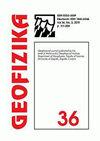数字高程模型分辨率对克罗地亚某研究区重力地形校正的影响
IF 1.1
4区 地球科学
Q4 GEOCHEMISTRY & GEOPHYSICS
引用次数: 3
摘要
高分辨率数字高程模型(dem)在过去十年中已经可用。在大地测量学和地球物理学中,它们被用作重力和梯度测量中地形质量效应建模的主要数据。在模拟过程中,重力地形改正量是反映测站周围地形质量变化的中心量。本文研究了地形校正计算的一部分:数字高程模型分辨率的影响。以克罗地亚共和国为研究区域进行计算。研究区新创建的DEM/DBM是基于陆地区域的全球数字地表模型ASTER和海洋区域的数字水深模型GEBCO。将已创建的ASTER/GEBCO DEM/DBM以1″分辨率重新采样,创建较低分辨率的DEM。克罗地亚共和国首次计算并出版了地形校正图。使用低分辨率DEM获得的地形校正解与使用1″的DEM获得的地形校正解之间的差异表明,对于分辨率低于5″的DEM, DEM分辨率对地形校正的平均影响从0,5·10-5到3·10-5 ms-2。结果还表明,崎岖和山区在这种计算中特别成问题。本文章由计算机程序翻译,如有差异,请以英文原文为准。
Influence of digital elevation model resolution on gravimetric terrain correction over a study-area of Croatia
High-resolution digital elevation models (DEMs) have become available in the last decade. They are used in geodesy and geophysics as the main data for modeling of topographic mass effects included in gravimetric and gradiometric measurements. In modeling process, gravimeric terrain correction is the central quantity which accounts for the variations of topographic masses around measured stations. This study deals with one segment of terrain correction computation: the impact of the resolution of digital elevation models. Computations are performed on study area of Republic of Croatia. Newly created DEM/DBM for the study area is created from global digital surface model ASTER for continental area, and digital bathymetric model GEBCO for the sea area. DEMs with lower resolution were created by resampling of the created ASTER/GEBCO DEM/DBM in 1″ resolution. Terrain correction map is computed and published for the first time for the Republic of Croatia. The differences between terrain
correction solutions obtained by using lower resolution DEMs compared to the solution obtained by using DEM with 1″ are indicating average influence of DEM resolution on terrain correction from 0,5·10–5 to 3·10–5 ms–2, for DEMs with lower resolution than 5″. The results also reveal that rugged and mountainous areas are particularly problematic in such computations.
求助全文
通过发布文献求助,成功后即可免费获取论文全文。
去求助
来源期刊

Geofizika
地学-地球化学与地球物理
CiteScore
1.60
自引率
0.00%
发文量
17
审稿时长
>12 weeks
期刊介绍:
The Geofizika journal succeeds the Papers series (Radovi), which has been published since 1923 at the Geophysical Institute in Zagreb (current the Department of Geophysics, Faculty of Science, University of Zagreb).
Geofizika publishes contributions dealing with physics of the atmosphere, the sea and the Earth''s interior.
 求助内容:
求助内容: 应助结果提醒方式:
应助结果提醒方式:


